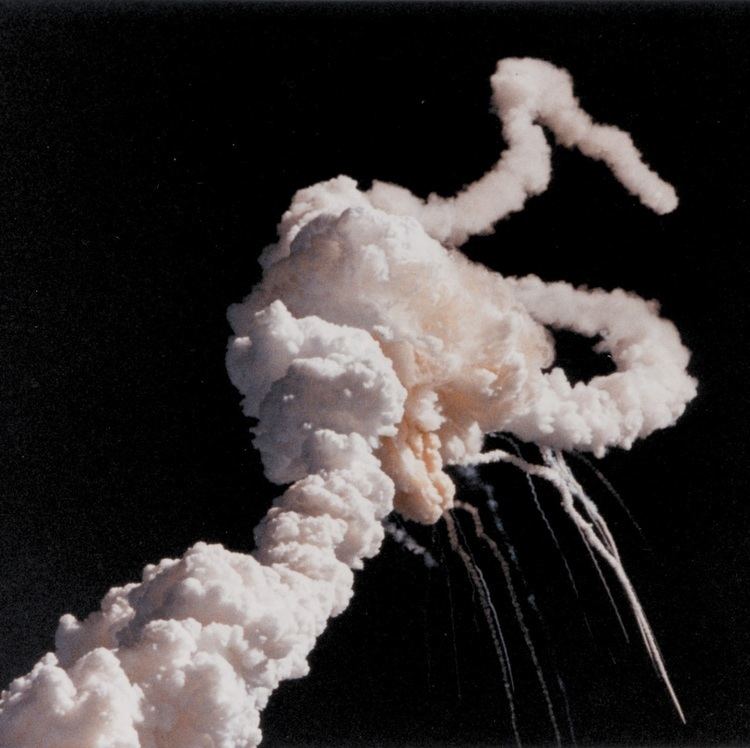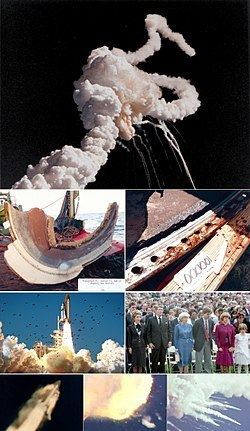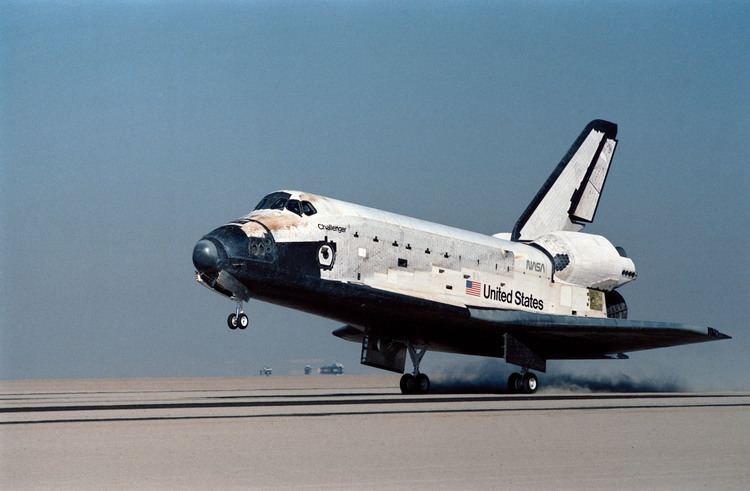OV designation OV-099 Contract award January 1, 1979 First flight STS-6April 4–9, 1983 Cost 196 billion USD (2011) | Country United States Named after HMS Challenger (1858) Max speed 28,970 km/h | |
 | ||
Status Destroyed January 28, 1986 Similar Space Shuttle Columbia, Space Shuttle Discovery, Space Shuttle Endeavour, Space Shuttle Atlantis, Space Shuttle Enterprise | ||
Space shuttle challenger explosion live tv
Space Shuttle Challenger (Orbiter Vehicle Designation: OV-099) was the second orbiter of NASA's space shuttle program to be put into service following Columbia. The shuttle was built by Rockwell International's Space Transportation Systems Division in Downey, California. Its maiden flight, STS-6, started on April 4, 1983. It launched and landed nine times before breaking apart 73 seconds into its tenth mission, STS-51-L, on January 28, 1986, resulting in the death of all seven crew members, including a civilian school teacher. It was the first of two shuttles to be destroyed in flight, the other being Columbia in 2003. The accident led to a two-and-a-half year grounding of the shuttle fleet; flights resumed in 1988 with STS-26 flown by Discovery. Challenger itself was replaced by Endeavour which was built using structural spares ordered by NASA as part of the construction contracts for Discovery and Atlantis.
Contents

History

Challenger was named after HMS Challenger, a British corvette that was the command ship for the Challenger Expedition, a pioneering global marine research expedition undertaken from 1872 through 1876. The Apollo 17 lunar module that landed on the Moon in 1972 was also named Challenger.
Construction
Because of the low production volume of orbiters, the Space Shuttle program decided to build a vehicle as a Structural Test Article, STA-099, that could later be converted to a flight vehicle. The contract for STA-099 was awarded to North American Rockwell on July 26, 1972, and its construction was completed in February 1978. After STA-099's rollout, it was sent to a Lockheed test site in Palmdale, where it spent over 11 months in vibration tests designed to simulate entire shuttle flights, from launch to landing. In order to prevent damage during structural testing, qualification tests were performed to a factor of safety of 1.2 times the design limit loads. The qualification tests were used to validate computational models, and compliance with the required 1.4 factor of safety was shown by analysis. STA-099 was essentially a complete airframe of a Space Shuttle orbiter, with only a mockup crew module installed and thermal insulation placed on its forward fuselage.
NASA planned to refit the prototype orbiter Enterprise (OV-101), used for flight testing, as the second operational orbiter, but Enterprise lacked most of the systems needed for flight, including a functional propulsion system, thermal insulation, a life support system, or most of the cockpit instrumentation. Modifying her for flight article status would have been far too difficult, expensive, and time-consuming. Since STA-099 was not as far along in the construction of its airframe, it would be easier to upgrade to a flight article. Because STA-099's qualification testing prevented damage, NASA found that rebuilding STA-099 as OV-099 would be less expensive than refitting Enterprise. Work on converting STA-099 into Challenger began in January 1979, starting with just the crew module (the pressurized portion of the vehicle) as the rest of the orbiter was still used by Lockheed. STA-099 returned to the Rockwell plant in November 1979, and the original unfinished crew module was replaced with the newly constructed model. Major portions of STA-099, including the payload bay doors, body flap, wings and vertical stabilizer, also had to be returned to their individual subcontractors for rework. By early 1981, most of these components had returned to Palmdale and were reinstalled on the orbiter. Work continued on the conversion until July 1982.
Challenger (and the orbiters built after it) had fewer tiles in its Thermal Protection System than Columbia, though it still made heavy use of the white LRSI tiles on the cabin and main fuselage compared to the later orbiters. Most of the tiles on the payload bay doors, upper wing surfaces, and rear fuselage surfaces were replaced with DuPont white Nomex felt insulation. These modifications as well as an overall lighter structure allowed Challenger to carry 2,500 lb (1,100 kg) more payload than Columbia. Challenger's fuselage and wings were also stronger than Columbia's despite being lighter. The hatch and vertical stabilizer tile patterns were also different from that of the other orbiters. Challenger was also the first orbiter to have a head-up display system for use in the descent phase of a mission, and the first to feature Phase I main engines rated for 104% maximum thrust.
Flights and modifications
After its first flight in April 1983, Challenger quickly became the workhorse of NASA's Space Shuttle fleet, flying far more missions per year than Columbia. In 1983 and 1984, Challenger flew on 85% of all Space Shuttle missions. Even when the orbiters Discovery and Atlantis joined the fleet, Challenger flew three missions a year from 1983 to 1985. Challenger, along with Discovery, was modified at Kennedy Space Center to be able to carry the Centaur-G upper stage in its payload bay. If flight STS-51-L had been successful, Challenger's next mission would have been the deployment of the Ulysses probe with the Centaur to study the polar regions of the Sun.
Challenger flew the first American woman, African-American, Dutchman and Canadian into space; three Spacelab missions; and performed the first night launch and night landing of a Space Shuttle. Challenger was also the first space shuttle to be destroyed in an accident during a mission. The collected debris of the vessel is currently buried in decommissioned missile silos at Launch Complex 31, Cape Canaveral Air Force Station. A section of the fuselage recovered from Space Shuttle Challenger can also be found at the “Forever Remembered” memorial at the Kennedy Space Center Visitor Complex in Florida. From time to time, further pieces of debris from the orbiter wash up on the Florida coast. When this happens, they are collected and transported to the silos for storage. Because of its early loss, Challenger was the only space shuttle that never wore the NASA "meatball" logo, and was never modified with the MEDS "glass cockpit". The tail was never fitted with a drag chute – it was fitted to the remaining orbiters in 1992. Also because of its early demise Challenger was also one of only two shuttles that never visited the Mir Space Station or the International Space Station - the other one being its sister ship Columbia.
